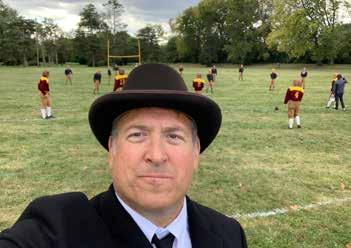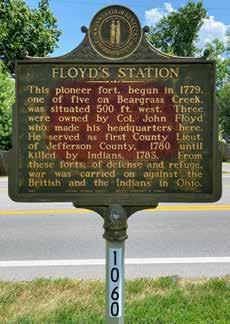
Remembering Colonel John Floyd
One of Louisville’s Founding Fathers Gave His Life to Settle the Kentucky Frontier

SHE’S GOING THE DISTANCE
ST. MATTHEWS RESIDENT TAVI WALLACE HAS FINISHED NOT ONE, BUT TWO ULTRAMARATHONS




One of Louisville’s Founding Fathers Gave His Life to Settle the Kentucky Frontier

ST. MATTHEWS RESIDENT TAVI WALLACE HAS FINISHED NOT ONE, BUT TWO ULTRAMARATHONS





“They have an activities sheet every day with many many choices, so I think that’s very good too. Plus, housekeeping is terrific, and they do my laundry once a week and they fold it beautifully. Finally, the care staff here are attentive to me. They show attention. They show care. All in all, I would highly recommend Vitality Living St. Matthews!”
- Matthew Lemberger, Resident











Natalie Harris has hardly known a time when she wasn’t in the housing industry. It all started with a church in Birmingham.
“I grew up in Birmingham, Alabama, and I went to a church that took people to work on people’s houses,” she reflects. “I was able to do that in high school and then every summer while I was in college, and it really became a passion for me.”
These early experiences led her to pursue a career that would allow her to serve the unhoused. “I originally got into housing because it was so impactful,” she says. “You could immediately see how housing changes somebody’s life.”
Harris worked as chief executive officer of Miami Valley Housing Opportunities for about four years, where she “got to actually do the building itself - to start with a project, have an idea, get the funding, get the units built and renovated, and move people in. That was really good for me.”
Most of her other positions, however, have been as director, focusing on the coordination, resources and policy behind building projects, with organizations including the Kentucky Housing Corporation, Homeless and Housing
Coalition of Kentucky, and Appalachia Service Project. She has also served as a consultant for various housing-focused organizations. Now she works as the executive director of Louisville’s Coalition for the Homeless.
“The Coalition for the Homeless was created to prevent and address homelessness here in Louisville,” she says. “We have been around for over 30 years, and were created when, across the nation, but also here in Louisville, there started to be an increase in homelessness, which had not been the case before. [We] were even seeing families that were becoming homeless in the ‘80s, so the city and county got together and created a task force. The Coalition for the Homeless is what came out of that.”
She says the organization’s team works as the overarching agency coordinating all the services of 40-plus different agencies serving homeless people. “That includes homeless shelters, night-and-day shelters, a health-care-for-the-homeless program, family health centers and legal services. There’s lots of outreach teams that go out on the streets to work with people there. All of those folks work together to try to create a system that’s more efficient and makes the best use of what limited resources we have.”
To Harris, it’s not an organization - it’s a team. “We work together to apply to the federal government every year to acquire homeless funding, and we have been very successful in bringing more money into Louisville, simply because we all work together. Working together does make a difference.”
The team includes a board whose members have experienced homelessness, and the team works in concert with currently unhoused community members. “The thing

that is most exciting to me is when you can bring people together and increase the power of their voice, by not just being one person, but having a collective voice,” Harris says. “And because most of the people that we’re serving have very little power, they live lives where they get used to just feeling like, ‘I have no power. There’s nothing I can do here’ - when in truth, if those people could work together and share their voice, we can do more.”
That “doing more” ranges from passing bills to gaining ordinances and more.
But working together doesn’t apply to the coalition team alone. It is the duty of every member of Louisville’s community. “[Don’t] be afraid to ask how you can help,” Harris says. “I think a lot of people feel a little paralyzed about the situation and don’t understand, ‘Why is homelessness happening? Why are there people who are losing their housing? [We] need to be concerned about the safety of the people who are losing their housing and make their homelessness as quick and easy as possible so that they can quickly move right back into housing. My challenge would be to ask, to read, to feel free to call us, and we can tell you more and tell you how to get involved.”
Harris has seen a strong community interest in learning how to help with housing. She hopes this passion will continue as the organization moves forward.
“[We] would love to continue to partner together because we are all stronger when we’re working together,” she says. “That includes the city, business leaders, churches and others in the community that can get involved. One, to speak up and say, ‘We need to do something about this,’ but also to volunteer, to donate, to get involved in working with all these different agencies.”
She encourages readers to visit the coalition’s website, where they can learn more about signing up to advocate. “That is [for] both local policy here in Louisville, but also doing statewide policy or trying to change state laws,” she says. In addition, the website’s Member tab displays a list of all the agencies the coalition
organizes, and lists what donations and volunteer work each agency needs.
“[It] could be something as simple as coming and serving meals, or something as intense as going out and working with the outreach teams - meet with people, make sure they’re OK, help convince them to come inside,” Harris says. “Even providing after-school care to homeless children helps.”




These acts of service are one step in getting closer to realizing a mighty goal. “My goal would be to not need a Coalition for the Homeless anymore,” Harris says. “If we could have enough housing for everybody, then there really wouldn’t be an organization like ours. [There] would probably still need to be some direct service providers that are doing a limited amount of work for people who lose their housing, and then they can quickly get housed again. But there wouldn’t be a need for an organization that is coordinating over 40 different agencies, because we wouldn’t need that many agencies. That is our ultimate dream.”
Yet she turns her mind to the process of reaching her dream. “In the meantime, I think what is most important is for us to make sure that nobody has to sleep outside,”

she says. “Even if that means increasing shelter, and prevention money - money to pay people’s housing bills so that they don’t become homeless in the first place - until we can get enough housing built, that’s important too, because people who are homeless now shouldn’t have to wait until enough housing is built.”
Harris has, in the course of her life, seen the immense impact that this work makes.
“Housing is so important,” she says. “I do this work because everything else rests on having it - your health, education, employment, safety, wealth, independence, family and more.”
As the coalition’s agencies continue to work to support Louisville’s unhoused residents


in this sphere, she acknowledges their self-sacrifice, thanking “all of the people who work in the member agencies that are working so hard to keep people safe.”
Through their persevering efforts to coordinate an array of agencies, Harris and her team are working together to make not just houses, but homes.
For more information and to get involved, visit louhomeless.org.







project; it’s a heartfelt mission to create a haven that feels like home.
Step into the vibrant transformation at Arcadia Senior Living in Louisville, where the community and team have been on an exhilarating journey over the last six months. Brian Durbin, the president of Arcadia, took the reins in the summer of 2023 and has been orchestrating a symphony of enhancements ever since.
This isn’t just about a facelift; it’s a profound revitalization. Durbin and his dedicated team are not only giving the community a fresh look with a splash of paint and upgraded landscaping, but are also weaving a tapestry of warmth and care into the very fabric of Arcadia.
As a locally owned and operated gem, Arcadia prides itself on a personalized approach. Durbin emphasizes their commitment to quality dining, dynamic social activities, and the cultivation of meaningful connections with residents and their loved ones. This isn’t just a
“While we’re making great progress on the physical plant, the relationships we build with our residents and their families, and the support we provide them to live independently and enjoy life, is what matters most,” said Durbin.
Durbin’s enthusiasm is infectious as he shares his vision for a community that values relationships over renovations. The goal is not just to create a physical space, but also to foster an environment where residents thrive emotionally and socially. It’s about crafting a narrative of active living, where every day is an opportunity to create cherished memories.
“It goes back to building meaningful and deep relationships,” Durbin said. “The continuity and familiarity of people and friendships formed is a great value. We’ve seen the negative impact that loneliness and isolation can cause our seniors, and feel like
our campus offers a great solution for those looking to continue to stay active and enjoy life.”
Durbin’s advice to families is simple but profound: explore and experience. Visit multiple locations, feel the atmosphere, and connect with the people who will be an integral part of your loved one’s journey.
Arcadia isn’t just a place to live; it’s a vibrant community where residents become family, and the atmosphere resonates with warmth and genuine care. It’s not just a retirement community; it’s an invitation to a life well-lived, surrounded by people who care deeply about the well-being and happiness of every resident.


Ultramarathon running isn’t for the faint of heart. Ultramarathons are classified as any foot race over the standard marathon distance of 26.2 miles, with some as long as 100 miles. Tavi Wallace says she started running at a young age because she wasn’t great at other sports. She started competing in second grade, but by college she was burnt out and lacked the passion to run again.
“When I moved back to Louisville, a friend asked me if I had ever considered trail running,” Wallace says. “I had hiked before but never thought about trail running, but they’re the same kind of community of people. Once I got started, I fell in love with it.”
Wallace recently competed in the Javelina
Jundred on October 28 and 29 in the Sonoran Desert in Arizona. The race is a 2024 Western States Endurance Run qualifier and Golden Ticket Race. The field of runners is highly competitive, and the race is so famous that participants are drawn from a lottery.
“I was on my laptop at midnight on January 1 signing up for the lottery,” Wallace says. “The race is so popular that only two of us from Kentucky were chosen. It’s hard to get in, but the race itself is even harder to finish. Only about 50% of the runners complete the race.”
The trail itself is a mix of hard-packed granite, rocks and sand.
“The three loops are essentially the same so you start memorizing the scenery,” Wallace says. “I started knowing which cactus was which when I would run past them. I could also mentally prepare, knowing I would be finishing my water at a certain point but there would be a spot coming up to get broth or Gatorade. I like to know exactly when I would get my nutrition or electrolytes.”
Wallace started in the first wave of runners at 6 a.m. on Saturday and ran through the afternoon, evening and Sunday morning, finishing around 5 a.m. Wallace says she not only had to train for the distance, but also prepare mentally for the desert weather.
“There is no way to mimic the desert
weather except to just plan for it,” Wallace says. “The desert doesn’t really retain heat, so when you start out in the morning, it’s cold. Then as the day goes on it gets hot, and then cold again as it gets dark. Luckily, I used to live out there so I knew what I needed.”
As it turned out, she needed 10 pounds of gear including headlamps, clothing, water and electrolytes. Wallace says she trained for the additional weight, but it still strained her back during the race. The temperatures varied from 40 degrees in the dark, early morning hours, to the 90s during the hottest part of the day.
Wallace says she prepared herself by completing extremely long runs during the hottest part of the day. She says she also did night training and caffeine fasting. She abstained from caffeine the week before to lower her tolerance.
“A lot of us stop drinking caffeine the week before an ultramarathon and then introduce it at a certain point throughout the race,” Wallace says. “I called it the witching hour. I waited until about midnight when I started getting sleepy while running.”
Her coach challenged her to run the

entire race without her smartwatch. She says she relied on her intuition and what her body told her. After that many hours of running without sleep, the brain starts slowing down, Wallace says. So, it’s crucial to complete the race with a pacer. She says she thought she would just be listening to music but the pacer played a much more critical role.
“Some people can actually get lost during a race due to sleep deprivation, so that was
nice to have someone I could just follow without overthinking,” Wallace says. “The pacer’s capacity is 100% because they’re only completing a portion of the race, not all of it. It was nice to have someone to talk to while running to keep my brain engaged. These people don’t get the accolades they deserve.”
The Sonoran Desert is home to several varieties of animals and insects one might encounter during the race, including the









race’s namesake, a javelina. Wallace says she’s glad she didn’t run into one because the wild pigs are known to be aggressive.
“I did see a rattlesnake at the beginning of the race,” Wallace says. “I did see a tarantula too, but at that point in the race I was so tired I couldn’t even move out of the way of it. My pacer got a photo of it because it was so big.”
With a race so intense and a completion rate of about 50%, Wallace says she was on cloud nine once she finished. She says she wanted to devour food once she was done, but her body wasn’t ready. She says she drank milkshakes until her body was prepared for food. Wallace needed time for her body to recover, so she spent a few extra days enjoying the desert weather and relaxing by a pool.
“During the race and even before, you have to stay on top of your nutrition and hydration,” Wallace says. “The medical team will pull people out of the race for their safety. Some of them dropped during loop three, during the hottest part of the day. I don’t think I’ve ever been as proud as I was to finish the race, and I’ve raced a lot.”
Wallace says ultramarathon running takes a specific personality type. She says many competitors have had issues with


YOU HAVE TO STAY ON TOP OF YOUR NUTRITION AND
addiction or eating disorders in the past. Wallace says only a few people run 100 miles just for fun. She says with trail running, you don’t just need your body, but your brain as well. Wallace calls it complete sensory stimulation.
The Javelina Jundred is Wallace’s second ultramarathon, but does she have any more in the future? As of right now, she’s unsure. She says the training needed takes up an excessive amount of time.
“My first ultramarathon was in 2021, so you kind of forget as time goes on how much time and effort it takes to get ready for one,” Wallace says. “It’s very time-consuming, on top of just how hard the race is. To say I had no life during training is an understatement. It took up a lot of hours on my weekends.”
Wallace says she plans to serve as a pacer for her friends because they’ve served as one for her. She’s open to possibly completing a new, different ultramarathon if the right one presents itself. In the meantime, she plans to continue running and participating in shorter races.



A new documentary will tell the story of the National Football League’s beginnings, showcasing the untold story of the league’s inaugural game more than a century ago.
Named for the stadium in which the game took place, “Triangle Park” features many prominent NFL and media figures, and interviews with descendants of the two participating teams’ rosters, the Dayton Triangles and the Columbus Panhandlestwo of the NFL’s original 14 teams.
One of those featured is Louisville resident Matt Lucas, the great-grandson of the Panhandles’ Phil Nesser. Lucas had six relatives participate in the NFL’s first game, which took place in Dayton on October 3, 1920, with the Triangles defeating the Panhandles 14-0. He is excited to see the story told in “Triangle Park.”
“The documentary really came together when the creator and the director of the film, Allen Farst, ran into a couple of folks in Dayton,” Lucas said. “He talked to a couple of descendants and heard the story, but he’d never researched it. Allen started
digging into the game, and researched how pro football was in 1900 or so until the first NFL game.”
Lucas, a former University of Kentucky football player in the 1980s, is interviewed in the documentary and plays a couple of roles during reenactment scenes, including the portrayal of Ted Nesser, his great-uncle and the Panhandles’ coach. Lucas met Farst, an American director known for his work with sports, music and documentary films,
Writer / Gavin LaPaille Photography Provided Matt Lucas
at a Nesser family reunion, and gradually grew more involved with the project.
Farst had interest in the Nessers due to their prominence during the time period and the significant roles they played in the NFL’s inaugural game. Known as the “first family” of professional football, the Nessers have the most combined years and the most pro championships of any family in NFL history. The Panhandles were built around the Nesser brothers for nearly two decades, leading a team known as one of the generation’s best. A plaque recognizing the family’s accomplishments is displayed in Canton, Ohio, at the Pro Football Hall of Fame.
“The Nessers were six brothers who played pro football from the 1900s to 1926,” Lucas said. “They were the best and the biggest name in professional football at that time and were on the Columbus team. They would work on the railroad all day and then play in these area games. They would hop a ride on the railroad and played the majority of their games on the road, being the attraction for other cities.”
The film is narrated by sports broadcaster Michele Tafoya, and features other big names from past and present NFL history including Chris Collinsworth, Eric Dickerson, Joe Buck and Tony Dungy, among others. The film debuted at AMC Theaters in all 32 NFL host cities the day before Thanksgiving, and “Triangle Park” will eventually be available to stream on Amazon Prime and Apple TV+.
“It really started out as a small documentary and has grown into national prominence,” Lucas said. “Things kept being added and added. It’s a who’s who of Hall of Famers and media personalities. You name it, they’re in it. The film started out as a local story and has grown into this giant thing that a lot of people wanted to get involved with.”
In addition to the football aspect of the documentary, “Triangle Park” will highlight other aspects of the time period, including prohibition and women earning the right
to vote. The film illustrates how different life was for the first NFL players compared to what it is today, when equipment and pay were not nearly up to par with current times.
“My family worked on the railroad, and one of the biggest stories in this film is they show up and are ready to kick off this game, and no one had a whistle,” Lucas said. “Since we worked in the railroad, we had a whistle. They had to use a railroad whistle to play the







game. There are all these intermingling stories about how this was a changing of the guard because there was a new crop of players coming along. A lot of them had known each other a very long time, so you had all this drama and competing towns. The film touches on the social issues, football issues and political issues, and how the game brought all this together.”
In keeping with the family tradition, Lucas has spent much of his life around athletics. In addition to playing football at UK, Lucas has worked in the athletic departments at the University of Evansville, Virginia Tech and Eastern Michigan University, and also was a field tester for Nike. All his life, Lucas was told about his family’s historic connections to pro football, and frequently made trips to Canton and to Triangle Park, which is now home to youth baseball fields, when he was younger. Lucas said he knows there are many like him who have a huge interest in football, and believes the film will have wide appeal to those who make it their routine to watch games each week.
“It’s the passion to know how and why we got where we are,” Lucas said. “We are a football-loving country and it is our passion. No other country on earth



understands it like we do. There isn’t one sport that demands as much physically and mentally, and is as interdependent on each other as football is. Nothing works in football unless 11 people work together in complete unison. People will want to see this.”
While the NFL is currently a huge enterprise, its beginnings were not as promising, as the league struggled in its early years. “Triangle Park” shows some of the origin story of the league that many know and love today.
“We want many people to see it and be inspired by the story - to see where the NFL started and a lot of businessmen from Columbus and Dayton pulled together all these people to form this league,” Lucas said. “Starting from very humble beginnings to now being the elite sports league on this planet is nothing short of phenomenal. The first NFL headquarters was in Columbus. The first commissioner was Joe Carr and
he was the manager of the Panhandles. He knew we could make this league a longstanding, viable organization that people wanted to see.”
Lucas said he is very excited to see the story of the NFL’s first game - and his family’s large role in it - reach a wider audience, and connect with others who also have strong connections to the inaugural game.
“The most enjoyable part is simply to watch a story that was untold now become a real
story,” Lucas said. “There’s only one first game, and only two teams that played in that game. Somebody had to have a lot of guts and determination and faith to go against the establishment. To see my family involved and know what they went through to play a game they absolutely loved is great. It’s nice to see a group of people bound together for something they believe in. Those are the greatest stories. It’s awesome to see how the NFL has matured and how my family has been part of that.”








Sponsored By:

DOWN
1. Cavern sight
2. I problem?
3. High school subject
4. Bank loan security
5. Calculator, at times
6. Go unsteadily
7. Full of guile
8. Doctor’s orders
9. Beginning to freeze?
10. Aggressively publicize
11. Blood category
19. Coffee preference
20. Base caller
21. Pouches
22. Leaky faucet sound
24. Software error
26. Wanders
28. Annoyance
29. List
30. Dress-uniform part
32. Frost’s bite?
34. Thousand ___, Calif.
37. Ruined
39. Expected outcomes
40. River through Tours
42. Spoil, with “on”
43. It’s within your range
44. Word with heat or meat
46. Biblical conclusion
48. French beverage
50. Haole’s souvenir
51. Cheerleader’s asset
1.
47. Superior to 48. Deck
49. Chalet site, perhaps
52. Club
53. “Take this!”
54. Born in France?
55. Bounds
56. “Paradise Lost” setting
57. Bonus for waiting





Through the Great Depression and, much later, the 2020 COVID-19 pandemic, Family & Children’s Place has long been dedicated to protecting and healing the community.
Last year, Family & Children’s Place celebrated its 140th anniversary, making it one of the oldest nonprofits operating in the state. Throughout the course of its existence, the nonprofit took on many different names as it established itself and found its specialty in aiding families.
Continuing to ensure the organization can serve the community for over a century has taken a lot of work and dedication.
“This kind of work is important because I just believe every kid deserves the best they can have,” said Pam Darnall, CEO. “They deserve every opportunity - the same opportunities as kids who come from better-resourced neighborhoods and betterresourced homes,” she continued, noting that this does not mean that child abuse and neglect only occur in under-resourced homes.
Darnall has been with the company for nearly 30 years, spending 10 of them as CEO. The organization serves 30 counties in Kentucky and 10 counties in Indiana, operating out of several offices and satellite locations. The main campus is located in downtown Louisville in the building it owns at 1000 South 5th Street.
The group has also had a presence at the YMCA on 18th Street and Broadway downtown since the facility opened in 2019. Darnall recalls being present for the groundbreaking and grand opening of the building.
Being located at the YMCA allows Family & Children’s Place to provide mental health services to underserved populations.
The organization offers free individual, family, group and school-based counseling to its clients. Interventions offered include play therapy, trauma-focused cognitive behavioral therapy, eye movement desensitization and reprocessing, narrative therapy, and motivational therapy.
“Mental health impacts every one of us,”
Darnall said. “I’ve been a Y member for 30 years and I definitely believe that both our mental and our physical health are directly connected, and being in a location with already existing partners is how we want to be.”
Partnerships play a significant role in the organization and its impact on the community. Some other partnerships include Metro United Way, Community Coordinated Child Care, Norton Healthcare and Baptist Health Floyd, among many others.


“We are all about collaborating and working in partnerships with other organizations,” Darnall said.
An in-home service that the organization formed as a partnership with the Louisville Metro Department of Health and Wellness in the mid-1990s has since become a statewide program in Kentucky.
Family & Children’s Place (then called Family and Children’s Counseling Centers) developed HANDS (Health Access Nurturing Development Services) to provide additional support to new and expectant parents.
“It’s really to help new parents and parents to navigate the challenges of parenting, and to help them to have safe, loving, nurturing homes,” Darnall said. “That’s important because that really is how children are safe. That’s how they grow up in happy, healthy
homes: when parents have the supports they need.”
By 2003 the Cabinet for Health and Family Services implemented the program across the state. The state department handles the program across the state, and Family & Children’s Place still operates HANDS in all of Jefferson County.
Over 400 families took part in HANDS at Family & Children’s Place in 2022, with 59 families graduating from the program, according to the organization’s yearly impact report.
In 2022 HANDS was almost the highestexpensed program for the organization, second only to Greater Louisville Head Start, which encompassed over half of 2022’s expenses.
Family & Children’s Place has worked over




the last four years to bring Head Start back to Jefferson County in partnership with Community Coordinated Child Care.
“We work with five different child care centers in various locations, in all underserved locations, to make sure that there are services in areas that sometimes don’t have adequate services,” Darnall said.





birth to age 3 reach school readiness and supporting the family’s well-being, with the option of in-home instruction. Head Start works with children up to age 5 at the five child care centers.
In 2021 the program was able to serve 305 families, totaling 343 children. Darnall said the group’s goal is to aid 500 children through Head Start programs when classrooms are fully staffed.
Family & Children’s Place also looks to help children older than 5 years old thrive academically and mentally, through schoolbased programs. The programs are aimed at educating children and their caregivers about emotional literacy, substance abuse prevention, leadership and family support, by partnering with groups like Kentucky Career Center, First Financial Bank, Louisville Visual Arts and Louisville Orchestra.
The organization currently has a presence at three schools in Kentuckiana: Meyzeek Middle School, Engelhard Elementary School and Hazelwood Middle School.
Another service Family & Children’s Place offers in both Kentucky and Indiana is the Child Advocacy Center. The center is present at the organization’s main campus downtown called Kosair Charities Child Advocacy Center, in the new Jeffersonville office, and at Baptist Health Floyd in New Albany. The centers help children that have experienced sexual abuse, human trafficking and severe physical abuse.
The Kosair Charities Child Advocacy Center shares its location with Louisville Metro Police Department’s Crimes Against Children Unit and child protective services. The center also has prosecutors, medical experts and mental health clinicians on-site, according to the Family & Children’s Place website.






Those interested in supporting Family & Children’s Place can volunteer their time for the organization. Darnall said volunteers can help in a variety of ways such as helping to answer phones, fill mailers and prepare for events.
Volunteers are also able to help with the school-based services, for those who want to work hands-on with children and families.
Family & Children’s Place has been able to help families across Kentuckiana, but Darnall noted that it has been difficult obtaining enough funding to fully support the community’s needs.
“We really have had to significantly reduce the mental health services that we can provide,” Darnall said. “In fact, we’ve had to reduce our mental health services by 50% [over the last two years].”
While the community has been a great




support for Family & Children’s Place, Darnall said there are two main issues when considering funding. “Donating over the past year across our country has trended down, and so fewer people have fewer dollars to give, and we absolutely understand that,” Darnall said. “But the


other issue is that often when nonprofit organizations are able to get grants, they are extremely restricted on how they can be used.”
If an organization cannot use funds in the way specified by a local or federal grant, then the money has to be returned. Darnall said that often, grant funds that Family & Children’s Place received could not be used on salaries.
Restrictive grants can prevent nonprofits from having the luxury of deciding how to reinvest in their company, be it through raises or building expansions, which hampers the ability to help the community, according to Darnall. “That entity, especially one that’s been around for 140 years, knows how to do its business really well,” Darnall said.
Despite the financial challenges that the organization has faced over the last few years, in 2022 alone, Family & Children’s



Place was able to serve 2,270 families and 4,275 individuals, and continue its nearly century-and-a-half-long legacy of helping the community.
“There are organizations that have a historical impact on our community, and we’re one of those,” Darnall said.
To learn more, go to familyandchildrensplace.org.











 Writer / Erin Kinnetz Photography Provided
Writer / Erin Kinnetz Photography Provided
If you are a native plant lover, now is the time to head into the forest in search of spring ephemerals. These shy beauties have a very strange life cycle that helps them to get the nutrients and sunshine they need on the competitive forest floor. Instead of trying to compete with trees and shrubs through the summer and fall, these flowers pop out before the trees have budded out in spring, when forest floor is relatively bare. Some of these plants, like the yellow trout lily, will even complete all their food making, flowering and seed making for the year, in a brief two-month window, and then return to dormancy underground until the next spring. For many of our harmless, native bees, these flowers offer the first foods they will eat after winter. For us naturalists, it’s a welcome sight as we look forward to warmer weather and greener, fuller forest scenery.
So far, we’ve spotted toothwort, blue phlox, Allegheny spurge, rue anemone, and harbinger of spring. Soon we will see twinleaf, bloodroot, wild hyacinth, trillium, yellow trout lilly and more. While you may see spring ephemerals in many places, some of the best trails to check out for spring ephemeral sightings include the Moss Gibbs Woodland Garden in Broad Run Park, Wild Hyacinth and Paw Paw trails in Turkey Run Park, and Coppiced Woods Trail in Beckley Creek Park. Head out into the forest soon, as we only get a brief window to see these strange flowers!




John Floyd was an early settler of what is now St. Matthews. A pioneer statesman, surveyor, colonel in the Kentucky militia, and prominent in laying out the city of Louisville, Floyd can be remembered for many things.
He was born in 1750 in Amherst County, Virginia, to William Floyd and Abadiah Davis, both descendants of Welsh immigrants. He married early at the age of 18 to Matilda Burford, daughter of the sheriff of Amherst County. She died a year later giving birth to a daughter, Mourning Floyd.
Writer / Helen E. McKinney PhotographyBy 1772, Floyd had moved to Fincastle County, Virginia. where he taught school and lived in the home of Colonel William Preston, his mentor. Preston was a distinguished figure on the Virginia frontier and surveyor for the western part of the state. Two years later he commissioned Floyd as a deputy surveyor and appointed him chief of a seven-member surveying party headed to the Falls of the Ohio. Kentucky was a part of Fincastle County at that time.
A member of the surveying party, Thomas Hanson, kept a journal of the experience. Hanson kept records of how the party met up with bands of Natives in the forest, dining on a feast of bear meat, of Floyd laying off 2,000 acres of land on the Cole River for Colonel George Washington, and of lands surveyed in what was to become Kentucky for Patrick Henry and other prominent men. Floyd’s mission on this trip was to make a survey of the bounty lands offered to veterans of the French and Indian War. Eventually Natives drove the party back to Virginia.
In 1775 Floyd came to Kentucky again, via the Cumberland Gap. During the following summer he was living at Fort Boonesborough and participated in the rescue of Jemima Boone, Daniel Boone’s daughter, in July of 1776. He returned to Virginia once more, but would make his way back to Kentucky in 1779 with several siblings and his new wife, Jane Buchanan, Colonel Preston’s niece. He and Jane had three children.
He had returned to claim 2,000 acres he had purchased in 1774. With his family, he built a cabin near Third and Main streets in present-day Louisville as a temporary shelter. He soon established a settlement near Beargrass Creek known as Floyd’s Station, in present-day St. Matthews near Breckenridge Lane, and 10 more families settled there with him. All that remains today of the station are a spring house and cemetery.
In 1780, by an act of the Virginia General Assembly, Floyd became one of seven trustees of Louisville, thus enabling him to

assist in laying out the city. In 1781, General George Rogers Clark convinced Governor Thomas Jefferson to appoint Floyd as colonel of the Kentucky militia, justice of the peace, and surveyor of Jefferson County.
On September 13, 1781, a party of roughly 50 Miami Natives who had separated from a larger group two days earlier and were spurred on by the British, attacked settlers as they evacuated Squire Boone Jr.’s Painted Stone Station in Shelby County. The settlers were fleeing to Lynn’s Station, one of the Beargrass stations, and were attacked along the main ford of Long Run Creek, near the present-day site of the Eastwood Cemetery.
Several died but many also escaped and lived to tell their story of what became known as the Long Run Massacre. The

following day, Floyd led 27 men to the Eastwood/Middletown site in a rescue and burial mission. When they reached their destination, they were ambushed. Floyd narrowly managed to escape and the incident became known as Floyd’s Defeat. Historical records have noted that he rode a fine black horse called Shawnee into the defeat.
The next day, a force of 300 men from the Falls and Beargrass stations marched to the area and buried the dead from the first massacre and from Floyd’s militia rescue in mass graves. At the site of Floyd’s Defeat, the bodies were buried in a sinkhole with stones and tree limbs placed on top, in an effort to keep wild animals away. The names of the dead were said to have been carved on a nearby beech tree.




Two years later, in 1783, Virginia leaders organized the government of Kentucky and Floyd was appointed to be one of the first two judges of Kentucky. Sadly, he would not live to see the land achieve statehood. He was wounded on April 8, 1783, by Natives while traveling to Bullitt’s Lick. He died of his injuries two days later. At the time of his death, he had been wearing a scarlet coat bought from Paris, which his widow, Jane, preserved until her death in 1812. She had requested the coat be buried with her. It is thought that Floyd was buried near the site of Floyd’s Station.
All that remains to mark these harrowing real-life events is a historical marker about the massacre, and a monument erected to Floyd and his men. The monument sits off in a lonely field on the backside of town. If you’re there on a still September day and listen closely, you can almost hear Floyd as he shouted and swore, when he and his militia rode

This Creole Champion of St. Matthews, Lou Lou Food & Drink has thrived for years by delivering Louisville’s Louisiana connection in culinary delight. The New Orleans vibe is alive at Lou Lou on Market. The new concept continues its traditional Low Country cuisine, but Chef Cristian Garay adds his flair and creates a new menu.
812 East Market Street
502-515-9699

out of Lynn’s Station, “The first man to lose his gun this day will be hung!”
Floyd is remembered annually along with survivors and those who did not survive at the re-enactment of the Long Run Massacre and Floyd’s Defeat at Red Orchard Park in Shelby County. This year’s dates include Friday, September 6 (School Day, 9 a.m. to 1 p.m.; $4 per person - schools only).
Saturday, September 7 is open to the public from 10 a.m. to 4 p.m.



On Saturday a battle reenactment takes place at 2 p.m, and the public is welcome to visit the settler and Native camps, see a live cannon demonstration, prisoner exchange, and various demos of 18th-century heritage skills. As a special tribute, the Sons of the American Revolution present colors and descendants are recognized, all in tribute to those who gave their lives to settle the Kentucky Frontier. Admission cost for the Saturday event is $6 per adult, $3 for ages 3 to 12, and free for ages 3 and under.
For more info, to read the story of Floyd and his involvement in the Long Run Massacre, or to register for School Day, visit paintedstonesettlers.org.



Expires 5/31/2024
Expires 5/31/2024
If there is one budgeting category that people have a hard time with, it’s food…especially dining out. When you go to a restaurant, you’re not just paying for the cost of the food; you’re paying for the service, cleanup, tax, tip and markup. Something that would cost you $2.50 to make at home could easily cost you $25 at a restaurant.
Dining out adds up fast. I’ve spent countless hours doing research, experimenting, and seeking out best practices for how to get this under control. And don’t worry - I’m not advising you to stop eating out…that would be blasphemy! I’m here to show you some easy hacks you can implement right away to help you save on those large restaurant bills.
Tip 1:
Only drink water at restaurants. You can always buy tea, soda, or fix yourself an alcoholic beverage back at your house for a fraction of the cost.
Tip 2: Invest in a freezer. Often, the reason I eat out is because I just don’t want to cook (that’s a nice way of saying I’m lazy.) If you can relate to that, then start stocking up on frozen meals. Lasagnas, pizzas or healthy single-serve meals could save you from wasting money on takeout when you don’t have the time or energy to cook something.
Tip 3:
Avoid services like Postmates, Grubhub, Uber Eats and DoorDash. Not only are you paying all the extra costs of dining out, but you’re also paying a delivery fee and tip for the convenience. This can easily add another $5 to $10 to your meal. In fact, delete them from your phone altogether.
Tip 4:
When you order your meal, ask for a to-go box. Restaurant portions are enormous. It’s hard not to want to gobble down the entire meal right then, but more often than not, you walk away uncomfortably full. Save yourself from temptation by boxing up half your meal right when it comes out. That way, you get two meals for the price of one.
Even those who don’t eat out often can still struggle with their grocery bill. Plus, if you prefer certain brands or organic options, or you’re shopping for your family, your weekly grocery shopping bill can easily be hundreds of dollars.
Tip 5:
Avoid impulse shopping by using a curbside pickup service. ClickList with Kroger only costs $5, and Walmart pickup is free. You can order everything online ahead of time. That way, you ensure you’re sticking to only what is needed. No more getting up to the register and throwing in a couple candy bars (guilty!).
Tip 6:
Make your own freezer meals. Instead of spending $3.99 on single-serve meals, cook a casserole or batch of soup, divide leftovers into portions and freeze them. The next time you need something quick and easy, voilà!




The best part about being smart about your food budget is all the money you’ll be saving.
What are YOU passionate or excited about? Maybe it’s buying adorable baby clothes for your little one, or spoiling your dog, or shopping for new shoes, or buying that new small-batch bourbon. Start a fund for yourself and put a portion of the money you save on food towards that exciting reward. This will help you stay motivated.
And finally, there’s no time like the present! Implement these tips right away and see how quickly you can cut your food expense in half.
Rachel Richards is a real estate investor, former financial advisor, and bestselling author of two books on financial literacy: “Money Honey” and “Passive Income, Aggressive Retirement.” She is from Louisville.













When will interest rates go down?
Regardless if businesses are considering an expansion or if a person is buying their first home, second home or home away from home, this question remains topof-mind for many consumers and commercial clients.
The interest rate benchmark, set by the Federal Reserve, is called the Fed Funds Rate. Most investment and borrowing rates are based upon this benchmark. For example, the Prime Rate, a base for setting lending rates, is usually 3.00% above the Fed Funds Rate.
A Fed Funds Rate of 5.50%
equates to a Prime Rate of 8.50%. Because the Fed Funds Rate is so important, pundits may speculate as to when it will drop. I have a few theories on why there is so much discrepancy.
First, let’s look at the age of our workforce. Nearly 60% of our current workforce started in or after the year 2000. In May of that year, the Fed Funds Rate hit 6.50%, the highest in the last 25 years. Since that time, rates have declined, hitting 0.00% during the Great Recession, and staying at or near that level until 2022. During that period, there were a couple of interest rate blips, but when those happened, rates
quickly fell back to zero percent. We will call this period, the “Zero Rate Environment.” Most of our workforce and population only knows a Zero Rate Environment. Now that the Fed Funds Rate is 5.50%; the logical expectation is a rapid decline back to zero.
Secondly, when I hear experts espouse a rapid decline, I look to the industry they represent and how rate movement benefits them. Take for example, Wall Street investment firms. They want low rates so people invest in stocks and not money market depository accounts or certificates of deposit. Or, private equity funds that have
built their business models on a Zero Rate Environment. They need it back so they can make money.
And, then, there are the developers, who have large downtown projects with high vacancy rates. These projects were financed at low rates and cash flowed at high occupancy rates. You can only imagine the effect of refinancing a loan rate from 4.50% to 8.50%. Then, add lower cash flow from fewer tenants and a major problem spreads industry-wide.
Another theory espoused is that rates will decline because it is an election year. Ironically, during the Zero Rate Environment, rates did tend to decline around elections. However, if you dig deeper into the timing, the Head of the Federal Reserve was also up for appointment by the President during those time periods. This fall, Chairman Jerome Powell is not up for reappointment. Maybe, if rates decline at that time, it will be based upon the data, and not politics.
Finally, let’s talk more about the Federal Reserve. They are in quite a quandary. They have a mandate to fight inflation and keep employment high.
While inflation has reduced, it still remains stubborn and is dropping slowly. Consumers are still spending and employment remains robust. Until spending or employment drops, the Federal Reserve will most likely hold rates at this level.
But, here is the more complicated quandary: The Federal Reserve has concerns over its own financial situation, along with the large level of the Federal Government’s Debt. On January 24, 2024, a Wall Street Journal article headline read, the “Fed posts largest-ever annual operating loss of $114.3 billion.” The reason is that their investment income on their US Treasuries is less than what they have to pay to banks at the Fed Funds Rate. Additionally, the Federal Government Debt has ballooned by a third since Covid. As a country, more of our federal budget is spent on interest costs. This contributes to tremendous inflationary pressure. However, the Federal Reserve needs to keep rates high to fight inflation, but lower rates to reduce their losses and interest rate costs on the Federal Debt. This is quite a predicament.
So, what does all this mean? Perhaps this is the cost of a “soft landing” and not another
recession. While $114 billion a year sounds like a lot of money, it is not compared to the trillions of dollars of National Debt. As a nation, we can afford to hold this course for a while and allow our society to become used to the higher rate environment, which is near the 100-year average rate environment. Due to the financial pressure on the Federal Reserve and our National Debt, the pundits may also be correct that interest rates will decline. As for the timing, only the Federal Reserve knows.
While none of us locally can always have a say on national level decisions, it’s in our communities where we see the health of our economy on display daily. Independence Bank is committed to the local businesses and families around Kentucky where we serve. As we navigate the changing rate environment together, we invite you to stop in and see us today. You can find us at our St. Matthews location at 3901 Shelbyville Road or online at 1776bank.com.
 Louis R. Straub, II President Loan Officer Independecne Bank
Louis R. Straub, II President Loan Officer Independecne Bank




































The UofL Health Orthopedic team are the go-to experts for advanced, tailored treatment plans with less recovery time. In fact, we lead the state in robotic surgical procedures that can minimize pain and improve quality of life in record time. We are renowned for high-level care and customized surgeries that treat everything from shoulders to toes, including spines. And as the official health care provider for UofL Athletics, we provide that same VIP care to every patient. With access to specialists all in one place, it’s a win-win-win for the fastest journey to recovery.
UofLHealth.org today.
Kevin Harreld, MD Orthopedic Surgeon